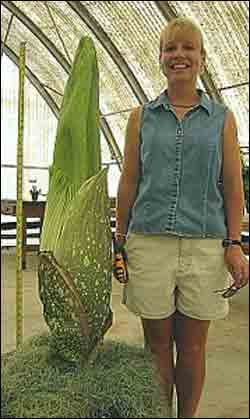Virginia Tech’s smelly ’corpse plant’ due to bloom Aug. 4

Virginia Tech has a second Amorphophallus titanum, or “corpse plant,” ready to bloom and emit its intensely powerful stench. People are invited to tie bandanas over their noses and come see the rare and unusual plant.
The horticulture greenhouse containing the plant is open to visitors Monday through Friday, July 26-30, and August 2-6, from 8 a.m. to 4 p.m. The likely date for the plant to bloom is Wednesday, Aug. 4, said Scott Rapier, greenhouse manager in the Department of Horticulture in Virginia Tech’s College of Agriculture and Life Sciences; follow the plant’s progress on the web at http://www.hort.vt.edu/VTHG/ if you want to see it on the date it blooms.
Although a blooming Amorphophallus titanum, or titan arum, is rarely seen, Virginia Tech’s first bloomed in August 2002, drawing crowds who braved the odor and the football traffic to see it. The smelly plant is rare because it puts forth one blossom every four to 10 years. This year, the second plant, located in Virginia Tech’s greenhouse complex, should bloom ahead of football traffic, making it easier for the public to visit the greenhouse. The first of these plants in the United States bloomed in 1937 at the New York Botanical Garden, and since, only about 20 have bloomed in this country.
In 1999, when the plant bloomed in the Huntington Botanical Garden in California, more than 76,000 visitors held their noses and went to see it. In Fairchild Garden in Florida, 5,500 visitors made the trek to see the infamous blossom; and at the Botanic Garden of the University of Bonn, Germany, the line to see the flowering titan arum extended more than two miles.
The plant invests a lot of energy during blooming to heat up the sulfur-based compound in the flower stalk so the carrion-like odor will spread several feet away from the plant to attract pollinators. The plant blooms seldom because of the amount of energy needed to bloom. To add to the plant’s humiliation, its pollinators include carrion beetles and flesh flies.
In spite of the plant’s long preparation for its flowery display, the blooms last, at best, two to three days, so visitors will have to be vigilant to see and smell it. A flowering stalk can be seven to 12 feet in height and three to four feet in diameter. After the bloom dies, a leaf stalk resembling a tree sapling will begin to emerge.
The plant was first discovered in 1878 in Indonesia, first cultivated at the Royal Botanic Gardens in England in 1887. The titan arum is in the same plant family as familiar house plants such as Dieffenbachia, Philodendrons, and Anthuriums.
To get to the greenhouse from Rt. 460, turn onto the Virginia Tech campus at Southgate Drive, turn left on Duck Pond Road, and right on Washington Street. Very shortly, you will see the greenhouses on the right. After taking the road into the greenhouse complex and reaching a gravel section between the glass and fiberglass greenhouses, stop at the first fiberglass greenhouse, number F-6, where the plant is located. Or follow your nose.
Media Contact
All latest news from the category: Life Sciences and Chemistry
Articles and reports from the Life Sciences and chemistry area deal with applied and basic research into modern biology, chemistry and human medicine.
Valuable information can be found on a range of life sciences fields including bacteriology, biochemistry, bionics, bioinformatics, biophysics, biotechnology, genetics, geobotany, human biology, marine biology, microbiology, molecular biology, cellular biology, zoology, bioinorganic chemistry, microchemistry and environmental chemistry.
Newest articles

Parallel Paths: Understanding Malaria Resistance in Chimpanzees and Humans
The closest relatives of humans adapt genetically to habitats and infections Survival of the Fittest: Genetic Adaptations Uncovered in Chimpanzees Görlitz, 10.01.2025. Chimpanzees have genetic adaptations that help them survive…

You are What You Eat—Stanford Study Links Fiber to Anti-Cancer Gene Modulation
The Fiber Gap: A Growing Concern in American Diets Fiber is well known to be an important part of a healthy diet, yet less than 10% of Americans eat the minimum recommended…

Trust Your Gut—RNA-Protein Discovery for Better Immunity
HIRI researchers uncover control mechanisms of polysaccharide utilization in Bacteroides thetaiotaomicron. Researchers at the Helmholtz Institute for RNA-based Infection Research (HIRI) and the Julius-Maximilians-Universität (JMU) in Würzburg have identified a…



